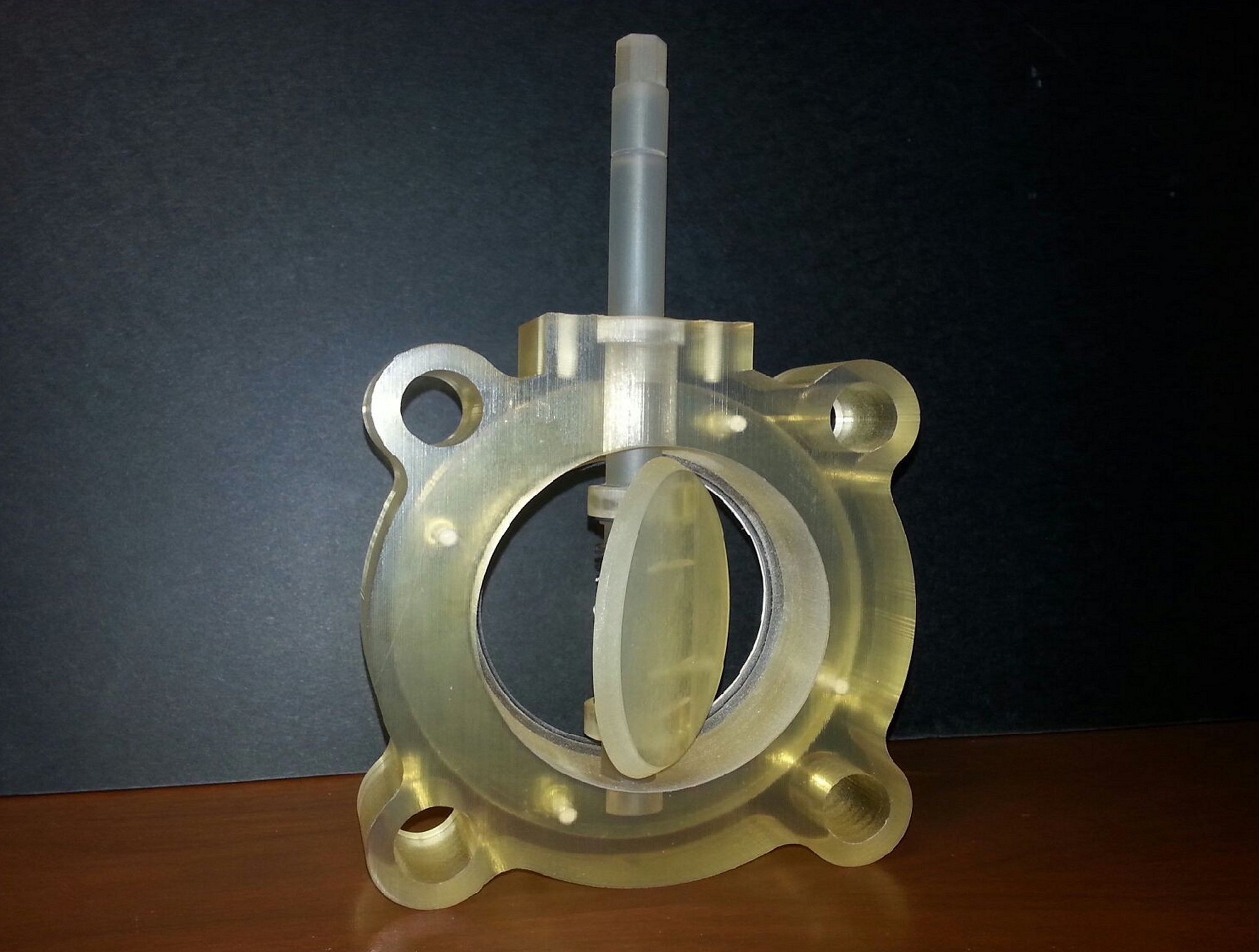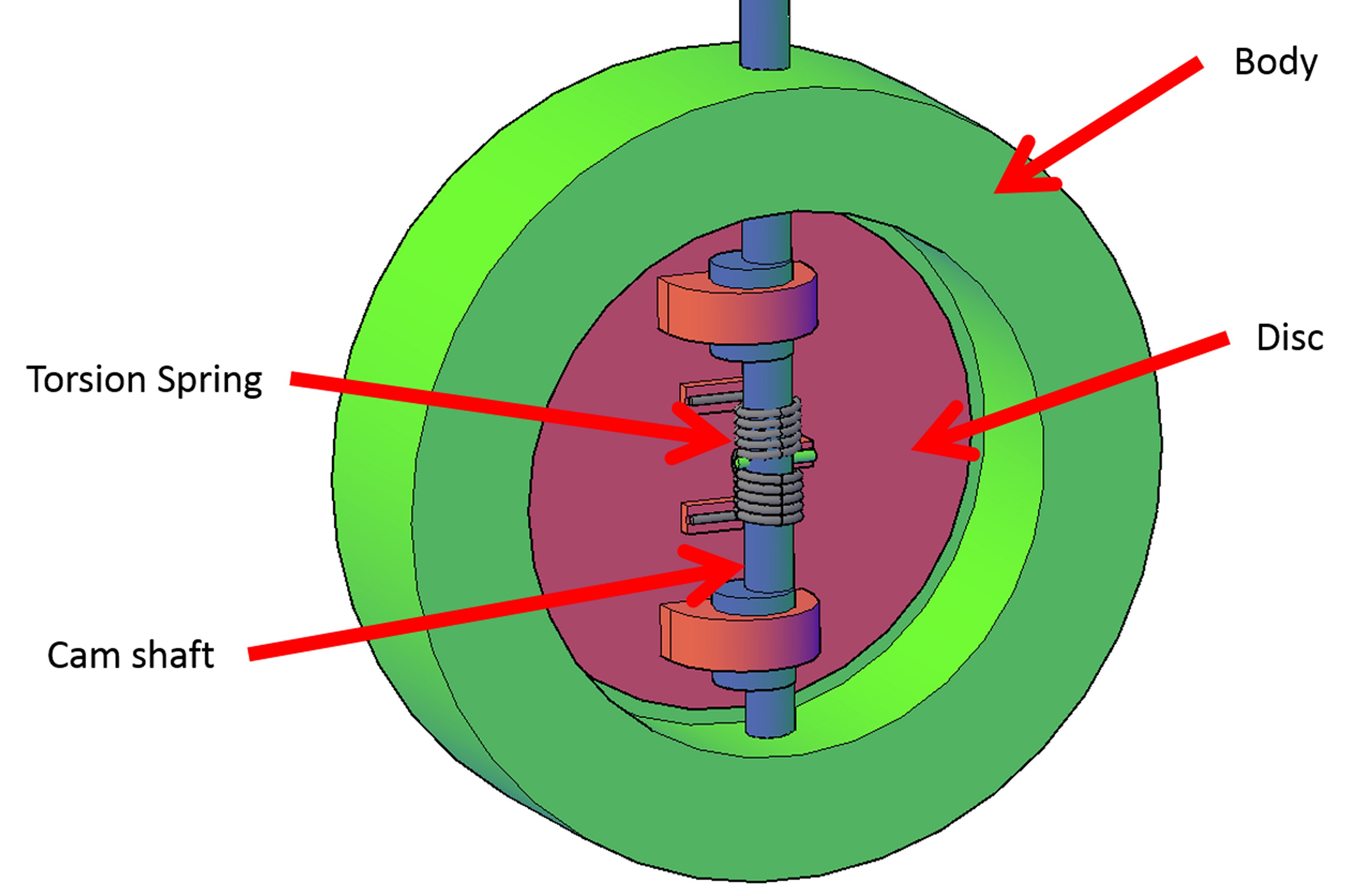Cryogenic Cam Butterfly Valve
mechanical and fluid systems
Cryogenic Cam Butterfly Valve (SSC-TOPS-9)
Tight seals across broad temperature ranges.
Overview
Typical butterfly valves cannot seal at both ambient and cryogenic temperatures. At cryogenic temperatures, valves grow and shrink, changing critical dimensions such as distance between the disc and seat. Ideally, valves would compensate. The inability of existing butterfly valves to do this triggered the innovative design of the Cryogenic Cam Butterfly Valve (CCBV). The CCBV is designed so that the disc rides on a cam shaft and is held rigid by a torsion spring, which provides both axial movement of the disc in addition to the standard 90 degree rotation of a standard butterfly valve. Because the valves disc can rotate and translate, it can hold a tighter seal, preventing leakage despite dimensional changes caused by changing operating temperatures. The novel concept enables functional advantages similar to a globe valve. The CCBV enables low leakage at both ambient and cryogenic temperatures. Compared to competing valves, it is a simpler design which results in reduced manufacturing and maintenance costs.
The Technology
A globe valve controls flow by translating a disc over an opening. A butterfly valve controls flow by rotating a disc in an opening. The disc and seat of a butterfly valve have to create a tight seal exactly when the disc meets the 90 degree mark. If additional torque (energy) is added to the actuator of a butterfly valve, the disc will rotate past 90 degrees and the valve will open again. Therefore, with a standard butterfly valve, additional actuator energy cannot be added to reduce or minimize seat leakage, like with a globe valve.
The novel Cryogenic Cam Butterfly Valve (CCBV) design functions like a typical butterfly valve, rotated to open or close the valve. However, unlike a typical butterfly valve disc that can only rotate, the CCBV can be translated and rotated to control flow. The main parts of the CCBV include a body, disc, cam shaft, torsion spring and 180 degree actuator. In the full open position, disc rotation is 0 degrees and the disc is approximately perpendicular to the valve body to enable maximum flow. However, unlike a typical butterfly valve where the disc is not pinned to the shaft, the CCBV has a preloaded torsion spring mounted concentrically on the shaft with the spring legs against the disc, and a pin to keep the disc coupled to the shaft. The torsion spring is preloaded with sufficient torque so that the disc/shaft assembly acts like the disc is rigidly pinned to the shaft. The first 90 degrees of the actuator and shaft rotation rotates the disc, just like a typical butterfly valve; however, at approximately 90 degrees, one edge of the disc makes contact with the body seat, while the opposite edge is slightly off of the body seat. At this point, the disc can no longer rotate. The cam shaft then converts rotatory motion into translational motion. Because of the cam shaft lobes, as the actuator continues to rotate the shaft, the disc can now translate towards the body, and enables more of the disc to seal against the body seat. Therefore, all actuator and shaft rotation beyond 90 degrees translates the disc towards the body seat to create a tighter seal, similar to how globe valve functions. When the valve is in this position, seat leakage will be reduced and with additional actuator rotation, stopped. Eventually, a tight seal is formed in the full closed position. Then, with opposite shaft rotation, the valve will open. The CCBV incorporated the advantages of a globe to achieve tight seals from ambient to cryogenic temperatures.


Benefits
- Improved performance over a wide temperature range
- Simple seat design
Applications
- Aerospace
- Petrochemical plants-piping systems
- Chemical industry-piping systems
- Cryogenic fluid systems, fluid
Similar Results

Cryogenic Hydraulically Actuated Isolation Valve
NASA's cryogenic isolation valve technology uses solenoid valves powered by direct current (DC) electrical energy to control and redirect the energy stored in the upstream line pressure. Powering the solenoid valves only requires a DC power source capable of supplying 22 watts that can be distributed and controlled in an on/off manner. By achieving actuation using only upstream line pressure and a 22-watt DC power source, many additional support systems that are required for electromechanical and pneumatic actuation are eliminated. This reduction of parts results in several benefits, including reduced footprint, weight, and potential cost of the valve in addition to lower energy consumption.
NASA fabricated several operational prototype valves using this technology for a rocket company. The table below shows the results of tests performed on these valves under cryogenic conditions. Please contact the NASA MSFC Technology Transfer Office for additional information.

Pilot Assisted Check Valve for Low Pressure Applications
Check valves are traditionally designed as a simple poppet/spring system where the spring is designed to equal the force created from the sealing area of the valve seat multiplied by the cracking pressure. Since the valve seat diameter in these types of valves are relatively small, less than 0.5 inches diameter, a low cracking pressure required for back pressure relief devices results in a low spring preload. When sealing in the reverse direction, the typical 20 psid storage pressure of the cryogenic fluid is not enough pressure force to provide adequate sealing stress. To better control the cracking pressure and sealing force, a bellows mechanism was added to a poppet check valve (see Figure 2). The bellows serves as a reference pressure gauge; once the targeted pressure differential is reached, the bellows compresses and snaps the valve open. Prior to reaching the desired crack pressure differential, the bellows diaphragm is fully expanded, providing sufficient seal forces to prevent valve flow (including reverse flow) and undesired internal leakage. Room temperature testing of cracking pressure, full flow pressure, and flow capacity all showed improvements. The overall results of the test proved to be 10-20 times greater than conventional check valves with no internal leakage at three different pressure differentials.

Miniature Separable Fill & Drain Valve
The Miniature Separable Fill & Drain Valve consists of two halves (ground and flight). The flight half is attached to the vehicle (i.e., CubeSat), and the ground half can be inserted into the vehicle in the same port as the flight half, connecting the two halves together. In normal state, the flight half seals the flow path. When the ground half is connected, the flow path is opened, allowing connected ground support equipment to supply fluid through the valve. The valve is manually operated.
There are redundant seals to eliminate leakage around the valve, including NASA's previously-patented Low-Cost, Long Lasting Valve Seal design (Patent No. 10,197,165; see MFS-TOPS-71 in the Links section of this flyer for more information) on the flight half. This eliminates the need for a swaged assembly process and the additional hardware and equipment that are typically required in conventional, elastomeric valve seat installations. The design also includes a cap for the flight half to ensure there is no leakage in flight configuration.
The Miniature Separable Fill & Drain Valve has been prototyped and provides valuable benefits for CubeSat applications. The valve could also have applications in the industrial processing industry where low flow devices are commonly used. The design is also scalable to larger applications where the removal of the actuation device would be desired.

Self-aligning Poppet
Without improvements in valve technologies, propellant and commodity losses will likely make long-duration space missions (e.g., to Mars) infeasible. Cryogenic valve leakage is often a result of misalignment and the seat seal not being perpendicular relative to the poppet. Conventional valve designs attempt to control alignment through tight tolerances across several mechanical interfaces, bolted or welded joints, machined part surfaces, etc. However, because such tight tolerances are difficult to maintain, leakage remains an issue.
Traditional poppets are not self-aligning, and thus require large forces to “crush” the poppet and seat together in order to overcome misalignment and create a tight seal. In contrast, NASA’s poppet valve self-aligns the poppet to the valve seat to minimize leakage. Once the poppet and seat are precisely self-aligned, careful seat crush is provided. Owing to this unique design, the invention substantially reduces the energy required to make a tight seal – reducing size, weight, and power requirements relative to traditional valves. Testing at MSFC showed that NASA’s poppet reduces leakage rates of traditional aerospace cryogenic valves (~1000 SCIM) by three orders of magnitude, resulting in leakage rates suitable for long-duration space missions (~1 SCIM).
NASA’s self-aligning poppet was originally targeted for aerospace cryogenic valve systems, especially for long-duration manned space missions – making the invention an attractive solution for aerospace valve vendors. The invention may also find use in the petrochemical or other industries that require sealing to prevent critical or hazardous chemicals from leaking into the environment. Generally, the invention may be suitable for any application requiring low-leak and/or long duration storage of expensive or limited resource commodities (e.g., cryogenic gases, natural gas, nuclear engines, etc).

Magnetically Damped Check Valve
NASA's Magnetically Damped Check Valve invention is a damping technology for eliminating chatter in passive valves. Because valve failure in space missions can cause catastrophic failure, NASA sought to create a more reliable check valve damper. The new damper includes the attachment of a magnet to the poppet in a check valve to provide stabilizing forces that optimize flow and pressure conditions. Test results have proven that the Magnetically Damped Check Valve offers substantial benefits.
The Magnetically Damped Check Valve works over a wide range of flow dynamics and eliminated chatter under all flow conditions tested, allowing valves to operate under various flow rates and pressures without a risk of degradation or total destruction from chatter. This technology could provide a more simple and cost-effective solution for valve manufacturers and system designers than solutions currently available in the market.
Applications for the new valve include use in aerospace or industrial processes. NASA's damping technology was originally designed for check valves, but could also benefit pressure regulators, relief valves, shuttle valves, bellows sealed valves or other passive valves.



